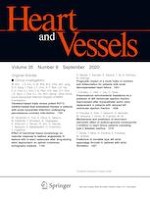Erschienen in:

26.03.2020 | Original Article
Predictors of movable type left atrial appendage thrombi in patients with atrial fibrillation
verfasst von:
Takeshi Oshita, Takanao Mine, Hideyuki Kishima, Eiji Fukuhara, Masaharu Ishihara
Erschienen in:
Heart and Vessels
|
Ausgabe 9/2020
Einloggen, um Zugang zu erhalten
Abstract
Left atrial appendage thrombi (LAAT) are the main cause of thromboembolic events. Especially, movable type LAAT is high-risk for thromboembolic events. We aimed to investigate the predictors of the movable type LAAT in patients with atrial fibrillation (AF). We retrospectively studied 827 consecutive patients who underwent transthoracic echocardiography (TEE) prior to cardioversion or catheter ablation for AF. Sixty-nine patients who underwent cardiac surgery or significant valvular disease were excluded. The remaining 758 patients (age 67.6 ± 9.3, 535 males) were included in this study. Clinical data were evaluated at the time of TEE. The LAAT were classified into movable and fixed type LAAT by three independent observers who did not know clinical data. LAAT were detected in 57 (11 with movable and 46 with fixed type) of 758 patients (7.5%). Patients with movable type LAAT had an elevated E/eʹ ratio, lower left ventricular ejection fraction (LVEF), larger left atrial volume index, elevated C-reactive protein, higher prevalence of non-paroxysmal AF, patients taking warfarin (73% vs. 21%, P < 0.0001), and structural heart disease than control group (fixed type LAAT and without LAAT). On multivariate analysis, E/eʹ ratio, LVEF, and taking warfarin were significantly associated with movable type LAAT. The rate of movable type LAAT was the highest (7 of 49 patients, 14.3%) in patients with elevated E/eʹ ratio (> 12.7) and decrease LVEF (< 44%). E/eʹ ratio and LVEF could predict movable type LAAT in patients with AF. High-risk patients might need powerful antithrombotic therapy or taking early TEE.